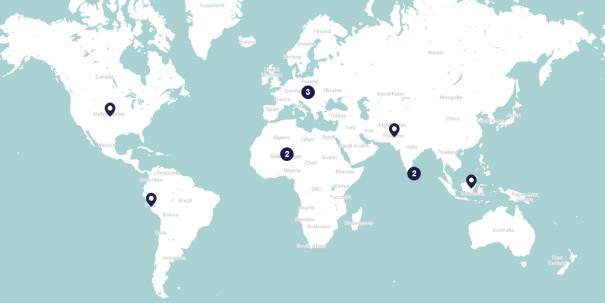
- Project summary
- 4 January 2021
Counseling Husbands to Achieve Reproductive Health and Marital Equity (CHARM)
- Author: Rebecca Justus
- Published by: Social Norms Learning Collaborative
Organizations involved
University of California San Diego School of Medicine; National Institute for Research in Reproductive Health (NIRRH); Population Council; T N Medical College; B Y L Nair Ch Hospital
Summary
CHARM was a three-session gender equity and family planning (GE+FP) counseling intervention delivered by male health care providers to married men, both alone and with their wives, to improve contraceptive use and reduce incident pregnancy and, secondarily, improve contraceptive communication and reduce IPV perpetration and acceptability in rural India. A two-armed cluster randomized controlled trial was conducted from 2012-2014 to evaluate the impact of the CHARM intervention on marital contraceptive use and incident pregnancy, and secondarily on contraceptive communication and men’s interpersonal violence (IPV) attitudes and perpetration. An additional analysis assessed longitudinally whether women's economic empowerment and financial inclusion predicts incident IPV.
Social norms of interest
Attitudes toward IPV; women’s economic empowerment
Behaviors of interest
Modern contraceptive use, contraceptive communication, pregnancy, IPV attitudes, IPV behavior
Project components
The intervention involved three gender, culture and contextually-tailored family planning and gender equity (FP+GE) counseling sessions delivered by trained male village health care providers to married men (sessions 1 and 2) and couples (session 3) in a clinical setting, or if required, near or in the participant’s home. (See citations below for details on curriculum content by session.) A desk-sized CHARM flipchart was used by village health providers to provide men and couples with pictorial information on family planning options, barriers to family planning use including gender equity-related issues (e.g. son preference), the importance of healthy and shared family planning decision-making, and how to engage in respectful marital communication and interactions (inclusive of no spousal violence in the men’s sessions). Sessions were delivered over a three month period. At each contact, village health providers also offered free condoms and oral contraceptive pills; the latter required women to visit the provider. In the control condition, women were referred to government health system FP services by front line public health workers (e.g. accredited social health activists- i.e. community outreach workers; the auxiliary nurse midwife) but village health providers were not used to engage men in FP services, as that is not the standard of care.
Social norms measurement
Participants were surveyed at baseline and 9 and 18-month follow-up (with a window of no more than one month around the due date). IPV attitudinal assessments were from India’s Demographic and Health Survey. Men’s Attitudes regarding Acceptability of Physical IPV were assessed via a seven item measure in which men were asked if “a husband is justified in hitting or beating his wife” in specified situations; responding yes on any of these items was defined as having attitudes accepting of physical IPV. Men’s Attitudes regarding Acceptability of Sexual IPV were assessed via a single yes/no item asking men “if a woman refuses to have sex with her husband when he wants her to, does he have the right to get angry and reprimand her?” Women were surveyed on economic empowerment, as measured by items on women's income generation and joint decision-making of husband's income, and financial inclusion, as measured by bank account ownership. Women's land ownership and participation in microloan programs were also assessed but were too rare to be included in analyses.
Key findings to date
Most men recruited from CHARM communities (91.3%) received at least one CHARM intervention session; 52.5% received the couple’s session with their wife. Findings document that women from the CHARM condition, relative to controls, were more likely to report contraceptive communication at 9-month follow-up (AOR = 1.77, p = 0.04) and modern contraceptive use at 9 and 18-month follow-ups (AORs = 1.57–1.58, p = 0.05), and they were less likely to report sexual IPV at 18-month follow-up (AOR = 0.48, p = 0.01). Men in the CHARM condition were less likely than those in the control clusters to report attitudes accepting of sexual IPV at 9-month (AOR = 0.64, p = 0.03) and 18-month (AOR = 0.51, p = 0.004) follow-up, and attitudes accepting of physical IPV at 18-month follow-up (AOR = 0.64, p = 0.02). No significant effect on pregnancy was seen.
At Wave 1 (baseline), one in ten women reported IPV in the past six months; 23% reported income generation; 58% reported having their own money; 61% reported joint control over husband's money, and 10% reported bank ownership. Women's income generation and having their own money did not predict IPV overtime. However, women maintaining joint control over their husband's income were at a 60% reduced risk for subsequent incident IPV (AOR = 0.40; 95% CI = 0.18, 0.90), and women gaining joint control over time were data 70% reduced risk for subsequent incident IPV (AOR = 0.30; 95% CI = 0.13, 0.72), relative to women whose husbands maintained sole control over his income. Women who initiated a new bank account by Wave 3 also had a 56% reduced likelihood of reporting incident IPV in this same wave (AOR = 0.44; 95% CI = 0.22, 0.93),relative to those who maintained no bank account at Waves 1 and 3.
Attribution statement
Raj, A., Ghule, M., Ritter, J., Battala, M., Gajanan, V., Nair, S., and Saggurti, N. (2016). Cluster randomized controlled trial evaluation of a gender equity and family planning intervention for married men and couples in rural India. PloS one, 11(5).
Raj, A., Silverman, J. G., Klugman, J., Saggurti, N., Donta, B., and Shakya, H. B. (2018). Longitudinal analysis of the impact of economic empowerment on risk for intimate partner violence among married women in rural Maharashtra, India. Social Science & Medicine, 196, 197-203.
